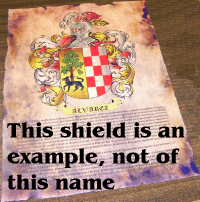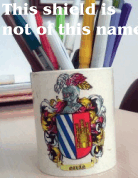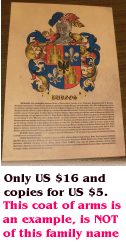
Parchment with the coat of arms, origin and history for the family name Montenegro. Very cheap.
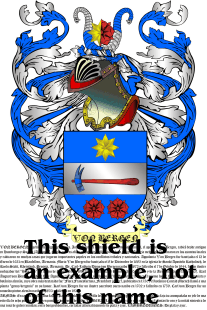
Coat of arms for Montenegro and the history and origin for the family name Montenegro in JPG or Vectorial files as Corel-Draw, AI, WMF, etc.
The history and heraldry of the family name Montenegro appears in the "Armorial Lusitano" by Antonio Sergio, so that, the Montenegro are either of Portuguese origin or with branches in Portugal. We must bear in mind that the Portuguese nobles are linked to the Castilian-Leonese and Galician nobility, in addition to Portugal was once united to Spain, what to keep in mind for the study of the family name Montenegro.
The Blasonario of the Iberian Consanguinity, where apper the heraldry of Montenegro, consists of 7 volumes, starting the first in the year 1979 and the last in the year 1997, being its authors Ampelio Alonso de Cadenas, the King of Arms Don Vicente de Cadenas y Vicent (maximum authority of Spanish heraldry) and Liliana Ruiz Carrasco. It compiles a set of coats of arms and crests from different Spanish archives, others from armor stones, many from military passports and more from nobility, such as the name Montenegro corresponding to a line whose origin or location is indicated, but without specific attribution to a specific family. It includes family names as Montenegro of an extensive universal geography but that were part of the Iberian Community.
The coats of arms and family crests with meaning for the family name Montenegro are collected in the Armorial General by Johan Baptiste Rietstap, this work is the greatest work of heraldry ever written and drawn, with more than 100,000 family names from around the world (English, Scotish, Welsh, Spanish, French, Italians, Poles, Portuguese, Dutch, etc.), among which is the name Montenegro, arranged alphabetically, and DRAWN, including a heraldic handbook with drawings, a complete glossary of terms, a supplement and an appendix. Complete description the coat of arms Montenegro, and origin for the family name Montenegro, nobiliary titles of the family name Montenegro and of the concession dates. The text where the family name Montenegro appears is in the second edition, expanded and revised from 1884-1887.
The family crest and coat of arms of Montenegro appears in Rietstap Armorial General that is a multi-volume work on the coats-of-arms of the world; it is both monumental and without equal, and is the most exhaustive undertaking of its kind. The Armorial General is the most authoritative work on the coats-of-arms in the world. The descriptions of the arms cover those of more than 100,000 families, included Montenegro alphabetically arranged and accurately described.In addition to a full description of the arms for Montenegro, most entries identify the nationality of the arms bearer, titles of Montenegro, and the date his title was conferred. The basic text was established with the publication of the second edition, corrected and enlarged, of 1884-1887. This most important reference work contains the shields of thousands of Coats of Arms covering the whole world, arranged alphabetically under surnames, as Montenegro.The very complete history and heraldry of the family name Montenegro appears in the big "Enciclopedia Hispanoamericana de Heraldica, Genealogia y Onomastica" written by brothers Arturo and Alberto Garcia Carraffa, and continued by Endika de Mogrobejo. There are more than 100 volumes that occupy this Encyclopedia where we can find the family name Montenegro. They are arranged alphabetically, although with additions at the end of many volumes. There are more than 17,000 names, including Montenegro.
The history and heraldry of the family name Montenegro appears in the book "Heraldica de los apellidos asturianos" by Francisco Sarandeses Perez. Here the lineage Montenegro It is found together with its heraldry in Asturias. This book is the fruit of more than 10 years of tireless work, of many excursions throughout the Asturian geography, crossing valleys, mountains, hamlets, places, villages, towns and cities, searching and searching in the most isolated corners that house that had a shield on its facade, like those of the lineage of the family name Montenegro, which led him to possess a formidable photographic archive on Asturian heraldry. It is a must for all those who want to undertake the study of Asturian heraldry. The heraldry and history of the name Montenegro appears here very well documented.
One of the most distinctive qualities of heraldry is the use of a limited palette of colours and patterns, usually referred to as tinctures. These are divided into three categories, known as metals, colours, and furs.
Next we are going to see the meanings of three tinctures:
1) PURPLE: Justice, Wit, Truth, Greatness, Wisdom and Love; those who wear this color are obliged to defend the Prince defending ecclesiastical people.
2) AZURE: Blue color that symbolizes Justice, Zeal, Truth, Loyalty, Charity and Beauty.
3) GULES: Red color that symbolizes Strength, Victory, Daring and Highness.
Next lets look at the characteristics of some figures that we can find in heraldry and crests:
* CHAIN: The Chain generally means Captivity suffered by the defense of the King or the Homeland.
* TIGER: The Tiger represents Fierceness and Valour; Resentment; Dangerous if aroused.
* NETTLE: The Nettle symbolizes Affliction.
* HAWK: The Hawk symbolizes Noble and Strong chest in companies of honor, which fails to achieve them faints of shame.
* HOLM: The Holm Oak is a symbol of Strong and Constant Spirit in heroic actions and courageous undertakings.
* MERMAID: The Mermaid is a symbol of Eloquence and Seduction.
* WOLVES: The Wolves are a symbol of a Constant Heart that suffers the calamities of war and siege with generous spirit; but when the time comes to fight in the open field, he fiercely fights, without giving his enemy a barracks.
* FUSIL: The Fusil is a symbol of Righteousness, Prudence and Equity and of the conveniences achieved through these virtues; it serves as a hieroglyph for those who gathered many goods using lawful and upright means.
* The family name Montenegro appears in the list of last names of Heraldry & Crests so its complete history, crest and coat of arms or heraldic shields can be known on his website: http://www.heraldrycrests.com/
Heraldry for family name Montenegro as well as its history is at your disposal here: Heraldry, history, origin, crest and coat of arms of the family name Montenegro
Related Words: Montenegro family crest | Origin of the name Montenegro | Genealogy of the family Montenegro | Heraldry of the name Montenegro | Coat of arms of Montenegro | Genealogy of the Montenegro | Origin of the Montenegro | Meaning of the name Montenegro.

Images of some books referred, with information of the family name Montenegro:
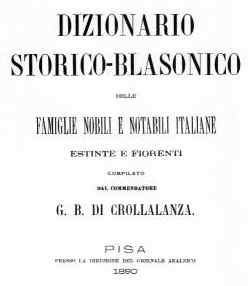
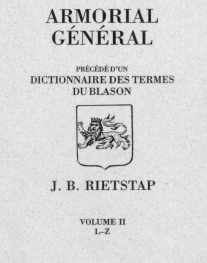
All the information about the surnames that are collected in this web site are based on verified bibliography.
Origin of family name, history and coat of arms/crests
